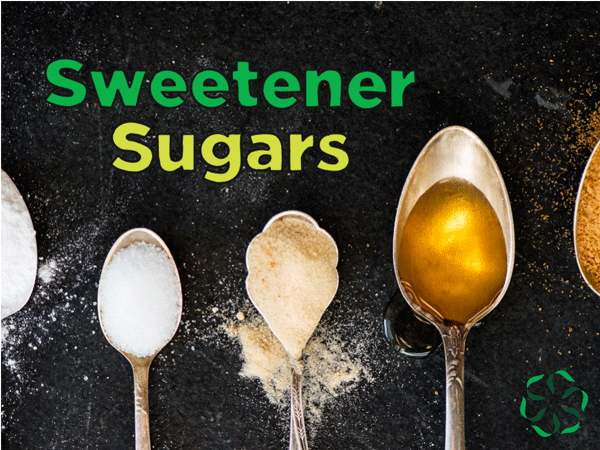In this series, we explore sweeteners. In this post, we cover common sugar sweeteners.
What is sugar?
Sugar is a type of carbohydrate found in many foods. Sugar can be the naturally occurring carbohydrates found in fruits, vegetables, grains, and dairy products. Sugar can also refer to the many types of sweeteners we add to food products such as honey, maple syrup, table sugar, corn syrup, high fructose corn syrup, and more.
What are the types of sugar?
There are many types of sugar. The simplest form of sugar includes glucose, fructose, and galactose. These simple sugars serve as the building blocks of compound sugars such as sucrose (glucose + fructose) which is regular table sugar, lactose (glucose + galactose) which is found in dairy products, and maltose (glucose + glucose) which is malt sugar. When ingested, the body will break down the sucrose, lactose, and maltose into simple sugars glucose, fructose, and galactose.
Many naturally occurring sweeteners are made up of the same building blocks. For example, maple sugar primarily contains sucrose (glucose + fructose) and water; honey can contains fructose, glucose, sucrose (glucose + fructose), maltose (glucose + glucose), and water. This means naturally occurring sweeteners also break down into the basic sugar building blocks.
We can look at a sweetener such as high fructose corn syrup and see that it too is composed of glucose and fructose, which, again, are two basic building blocks of sugar.
Is sugar bad for you?
As with most foods, moderation is key. Overconsumption of sugar leads to increased calorie intake and is associated with an increased risk of obesity, diabetes, and cardiovascular disorders.
Naturally occurring sugars found in whole fruits, vegetables, grains, and dairy products typically do not cause adverse health impacts because they are found with other naturally occurring fibers, minerals, protein, antioxidants, and more. The presence of these key nutrients, especially fiber helps slow down the absorption process of the naturally occurring sugar, helping us avoid overconsumption.
However, added sugar found in soda pop, fruit juices, pastries, candy, and more could be harmful to human health when consumed in excess1,2, because it is quickly digested and absorbed by the body making it easier to over-consume.
Are natural occurring added sugars different than high fructose corn syrup in the body?
Naturally occurring added sugars such as honey and maple syrup are processed in the body as the basic building blocks of sugar. The body uses the same process to digest high fructose corn syrup. This means overconsumption of naturally occurring sugar, like honey, can still lead to similar adverse health outcomes as over-consuming table sugar or high fructose corn syrup. Moderation is vital when consuming sweets, regardless of the source.
Do these sugars contain calories?
Yes, sugars contain calories; this includes honey, table sugar, high-fructose corn syrup, maple syrup, and more. It’s essential to notice the calories you’re consuming to ensure you are not accidentally over-indulging in sweets.

